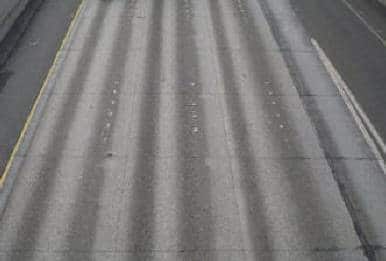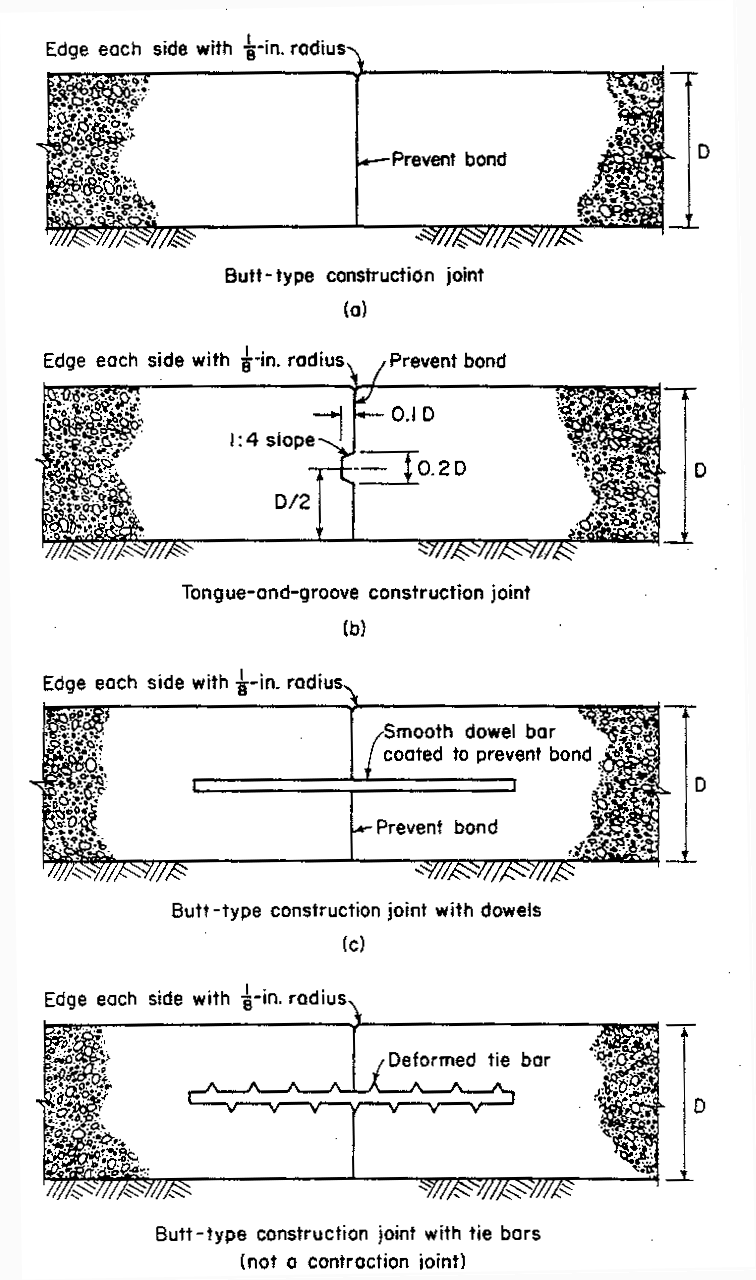Types of Joints in Concrete Constructions
Types of Joints in Concrete Constructions
Types of joints in concrete constructions are:- Construction Joints
- Expansion Joints
- Contraction Joints
- Isolation Joints
Construction Joints in Concrete
Construction joints are placed in a concrete slab to define the extent of the individual placements, generally in conformity with a predetermined joint layout.Construction joints must be designed in order to allow displacements between both sides of the slab but, at the same time, they have to transfer flexural stresses produced in the slab by external loads.
Construction joints must allow horizontal displacement right-angled to the joint surface that is normally caused by thermal and shrinkage movement. At the same time they must not allow vertical or rotational displacements. Fig.1 summarizes which displacement must be allowed or not allowed by a construction joint.

Fig.2: Types of Construction Joints in Concrete Structures
Expansion joints in Concrete
The concrete is subjected to volume change due to many reasons. So we have to cater for this by way of joint to relieve the stress. Expansion is a function of length. The building longer than 45m are generally provided with one or more expansion joint. In india recommended c/c spacing is 30m. The joints are formed by providing a gap between the building parts.Contraction Joints in Concrete
A contraction joint is a sawed, formed, or tooled groove in a concrete slab that creates a weakened vertical plane. It regulates the location of the cracking caused by dimensional changes in the slab.Unregulated cracks can grow and result in an unacceptably rough surface as well as water infiltration into the base, subbase and subgrade, which can enable other types of pavement distress.
Contraction joints are the most common type of joint in concrete pavements, thus the generic term “joint” generally refers to a contraction joint. Contraction joints are chiefly defined by their spacing and their method of load transfer. They are generally between 1/4 – 1/3 the depth of the slab and typically spaced every 3.1 – 15 m

Isolation Joints in Concrete
Joints that isolate the slab from a wall, column or drainpipe
Isolation joints have one very simple purpose—they completely isolate the slab from something else. That something else can be a wall or a column or a drain pipe. Here are a few things to consider with isolation joints:Walls and columns, which are on their own footings that are deeper than the slab subgrade, are not going to move the same way a slab does as it shrinks or expands from drying or temperature changes or as the subgrade compresses a little.

Even wooden columns should be isolated from the slab.
If slabs are connected to walls or columns or pipes, as they contract or settle there will be restraint, which usually cracks the slab—although it could also damage pipes (standpipes or floor drains).
Expansion joints are virtually never needed with interior slabs, because the concrete doesn’t expand that much—it never gets that hot.
Expansion joints in concrete pavement are also seldom needed, since the contraction joints open enough (from drying shrinkage) to account for temperature expansion. The exception might be where a pavement or parking lot are next to a bridge or building—then we simply use a slightly wider isolation joint (maybe ¾ inch instead of ½ inch).
Blowups, from expansion of concrete due to hot weather and sun, are more commonly caused by contraction joints that are not sealed and that then fill up with non-compressible materials (rocks, dirt). They can also be due to very long unjointed sections.

Very long unjointed sections can expand enough from the hot sun to cause blowups, but this is rare.
Isolation joints are formed by placing preformed joint material next to the column or wall or standpipe prior to pouring the slab. Isolation joint material is typically asphalt-impregnated fiberboard, although plastic, cork, rubber, and neoprene are also available.
Isolation joint material should go all the way through the slab, starting at the subbase, but should not extend above the top.
For a cleaner looking isolation joint, the top part of the preformed filler can be cut off and the space filled with elastomeric sealant. Some proprietary joints come with removable caps to form this sealant reservoir.
Joint materials range from inexpensive asphalt-impregnated fiberboard to cork to closed cell neoprene. Cork can expand and contract with the joint, does not extrude, and seals out water.
Scott Whitelam with APS Cork says that the required performance is what determines the choice of joint materials. How much motion is expect, exposure to salts or chemicals, and the value of the structure would all come into play—and of course the cost.
Polyethylene foam isolation joint material comes in various colors. C2 Products
At columns, contraction joints should approach from all four directions ending at the isolation joint, which should have a circular or a diamond shaped configuration around the column. For an I-beam type steel column, a pinwheel configuration can work.
Always place the slab concrete first and do not install the isolation joint material and fill around the column until the column is carrying its full dead load.
Read More: What is Cold Joint in Concrete? Methods of Treating Cold Joints


Best Knowledge of Joints in Concrete Constructions
ReplyDeleteThis is really informative post for cold joint concrete
ReplyDelete